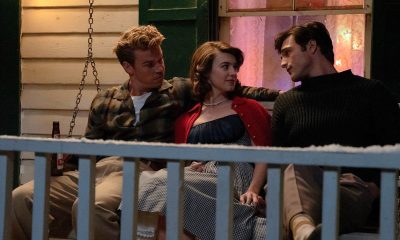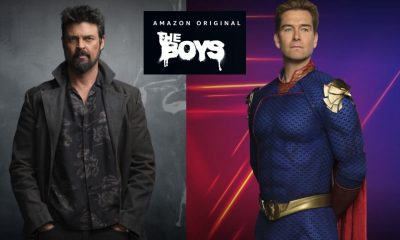Movies
Gnarly ‘Saltburn’ takes us on a sexy, savage ride
Buzzed-about film manages to shock even when we expect the jolt
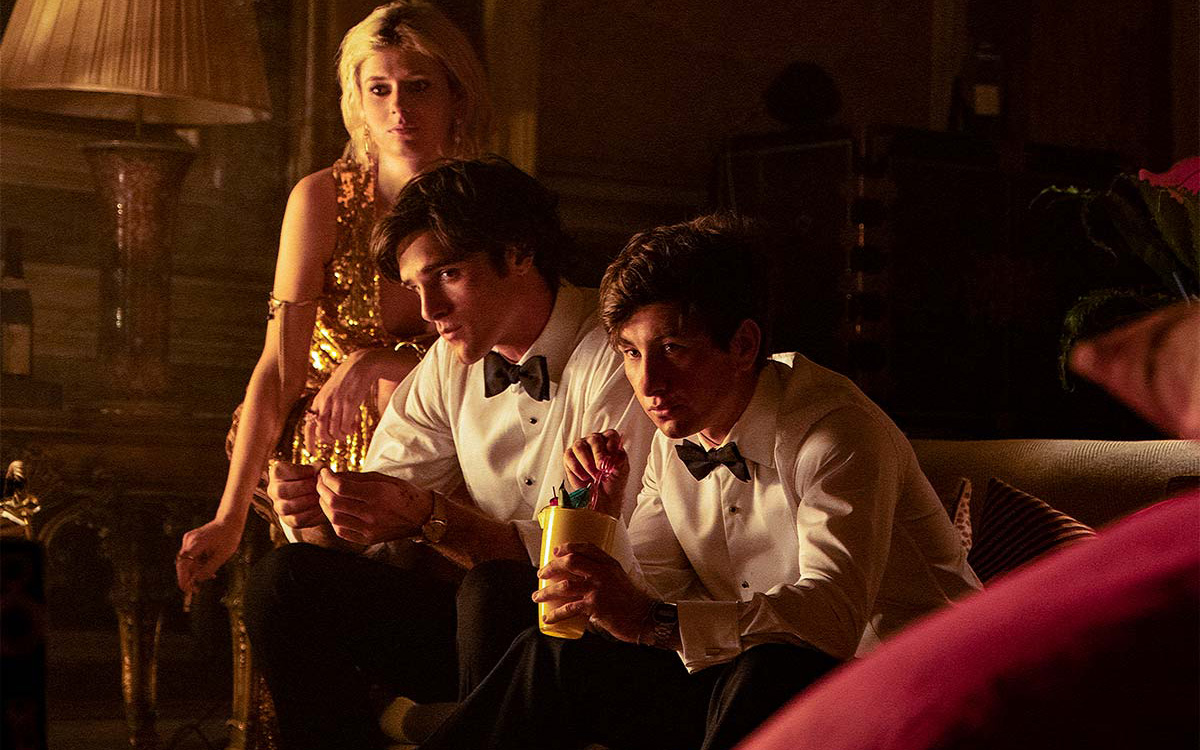
When a movie comes with as much buzz behind it as “Saltburn,” one can’t help but have expectations.
This is especially true when the buzz is fueled by rising talent, both in front of the camera (in this case, Oscar-nominee Barry Keoghan in his first leading role, alongside “Euphoria” sensation Jacob Elordi) and behind it (Oscar-winning writer/director Emerald Fennell, following up her debut feature, “Promising Young Woman”). When you add a deliberately vague, shamelessly provocative publicity campaign, which offers little more than a suggestion of the film’s premise while luring us in with imagery that implies a dark but sexy wild ride through the world of the decadent upper class, it’s almost impossible not to walk into the theater without feeling like you’re in for a thrill.
That, of course, is exactly what Fennell and company want you to feel. “Saltburn,” which opened in wide release the day before Thanksgiving, is a movie that counts on both your expectations and your ignorance; it needs you to be prepared for anything while knowing next to nothing, and it relies on your imagination to make assumptions and draw conclusions as you go. It’s the story of Oliver Quick (Keoghan), a first-year student attending Oxford University on scholarship in the mid-2000s. Relegated at first to outsider status among his privileged peers, he becomes infatuated with wealthy Felix Catton (Elordi), a handsome and popular classmate, and gains his attention through a chance encounter. The two become close companions, and when the school term ends he is invited to spend the summer with Felix at Saltburn – his family’s sprawling country estate.
It’s there the movie begins to follow a more gnarly path. Immersed in the idyllic, dilapidated luxury of Saltburn, Oliver finds himself entangled in the dysfunctional dynamic of the household; he easily wins the approval of Felix’s father and mother, Sir James and Lady Elspeth (Richard E. Grant, Rosamund Pike), but jealous sister Venetia (Alison Oliver), and scheming cousin Farleigh (Archie Madekwe), a “poor relation” who sees him as a threat to his own tenuous position in the family, are a different matter, and he must learn to navigate the behind-the-scenes politics required to keep them at bay.
It’s impossible, really, to say much more about the events that unfold beyond that point, other than to say that it’s a far cry from the nostalgic, semi-sweet gay coming-of-age story it might seem to be in the beginning, if the occasional ominous chord in the soundtrack and the glimpses of ugly human behavior on the screen didn’t suggest otherwise. “Saltburn” is one of those movies that demands to be seen knowing as little as possible about its plot if one is to get the full experience, and we won’t be revealing anything here that would ruin that – not even whether the “will-they-or-won’t-they?” steaminess of Oliver and Felix’s bromance ever comes to fruition.
What we will tell you is that Fennell – whose first film electrified audiences with a devastating twist ending – knows how to play an audience. She sets up “Saltburn” as a flashback; we know from the beginning that something big and presumably bad has happened, and its protagonist is a likable misfit who proceeds to narrate how it came to pass. From the film’s first moments, we are anticipating the twist – which begs the question of how a twist can be a twist if we already know it’s coming.
“Saltburn” addresses that question, though some viewers might not like the answer, by playing not just on our expectations, but on our hopes. While we may expect to be shocked, we also hope for a certain outcome; more than that, we become so attached to that hope that it can blind us to reality, so that when it finally hits us, it feels like we never saw it coming even though it was in plain view all along. That’s the best we can do in explaining how Fennell’s wickedly subversive, deeply disturbing mindfuck of a movie manages to shock us even when we expect the jolt.
Of course, it also delivers plenty of other shocks — drugs, sex, homoeroticism, lots of full-frontal nudity — before it gets there, and quite a few more disquieting, transgressive moments in which we see things that jar our understanding of what we are seeing or simply can’t believe what we’re seeing. When the gravesite scene comes up, you’ll know that’s one of the moments we’re talking about.
Still, it takes more than shock value to make a movie worth watching, and “Saltburn” doesn’t rest its laurels on a bag of manipulative tricks, no matter how skillfully they’re executed. Fennell’s movie delves deep into the economic class divide – a worldwide phenomenon epitomized by the genteel squalor of its upper-crust English setting – through its microcosmic portrait of the Catton family, whose benign and polite demeanor barely conceal the casual cruelty and shallow banality of their lifestyle. Even Felix – who, as superbly played by Elordi, seems genuinely kind and much more grounded than the rest of his clan – is ultimately a spoiled “golden child” used to getting what he wants and not above using his considerable charms to do make it happen. More than that, it plays with the uncomfortable notion that there’s a part in all of us, no matter how much we may deplore the perceived excesses of the one percent, that would be willing to do anything to live in that world. Indeed, it’s this conflicted idea that gives Fennell’s movie its teeth, made even sharper by the fact that, no matter how ridiculous or downright awful her characters may be, she makes us feel for – and even like – all of them.
Of course, she’s also an extremely literate Englishwoman, and she peppers her movie with references and themes from Shakespeare to Dickens to Agatha Christie, while paying ironic homage to the entire “country house” genre of British fiction. Her film craft is bold and distinctive, delivering (with the help of cinematographer Linus Sandgren) pastoral pleasures and Fellini-esque Bacchanales with equally arresting style. She deploys the talent of composer Anthony Willis to provide a stately-yet-gothic musical score that thrums with a low warning of menace, keeping us on edge throughout. And she has the good sense to assemble a superb cast – with the dryly hilarious Pike and the quietly heartbreaking Oliver as standouts, alongside Elordi – to make it all work.
It’s Keoghan, though, who is ultimately the glue holding “Saltburn” together. His Oliver Quick is a character destined to become iconic, a one-of-a-kind portrait of enigmatic humanity that bestows movie star status upon the young Irish actor after a steadily impressive roster of high-profile supporting roles. When the film is over, you will either love him or hate him, but you will never forget him.
In fact, the same can be said about “Saltburn” itself, which has had its share of negative reviews from critics put off by its over-the-top style and manipulatively orchestrated storytelling. We’d have to respectfully disagree; it’s an outrageous movie, to be sure, but purposefully so – and as for the storytelling, it is through its unapologetic manipulation that a movie which might easily otherwise have been just another mindless, lurid thriller into a savage piece of cinema that you’ll want to see again and again.
Movies
A bad romance is brought to light in ‘300 Letters’
All is not as it seems on social media in gay ‘anti-romcom’
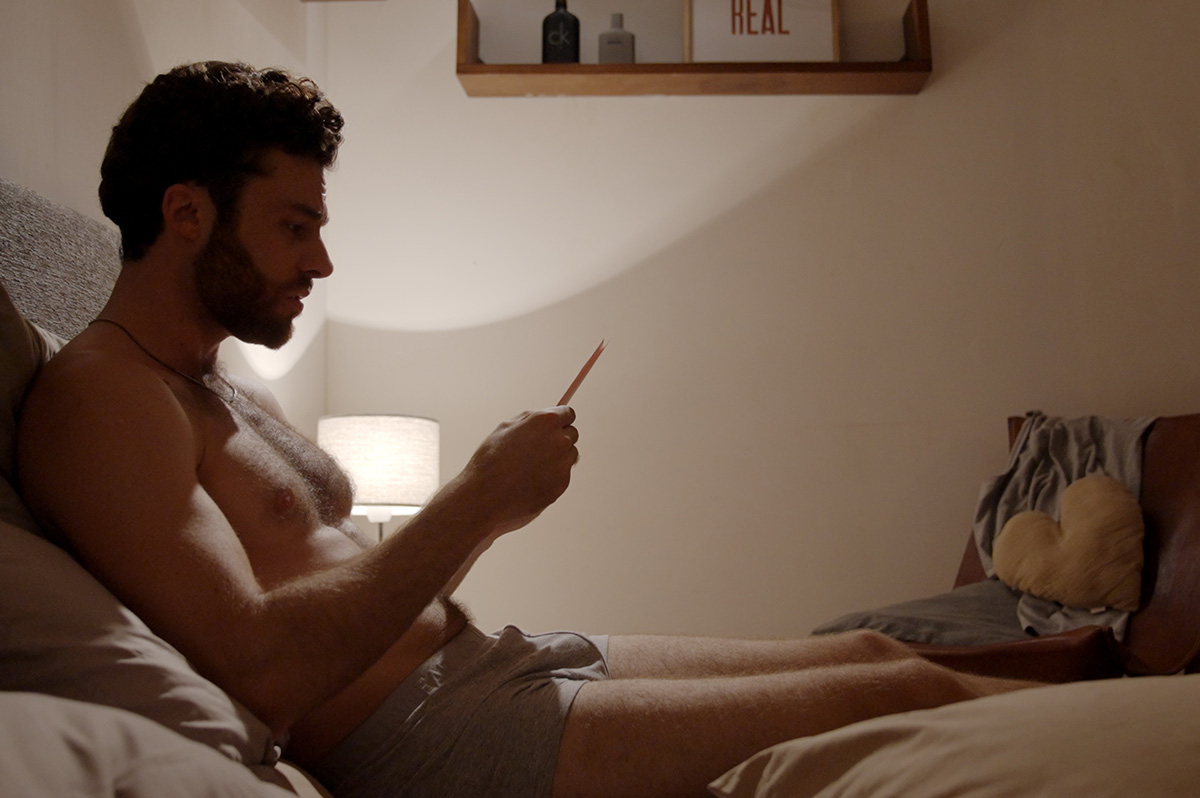
We’ve all known them. We’ve all watched those couples on our “friends” feed who seem to live a perfect life together; young, attractive, and devoted to each other, they present an aspirational image on social media, documenting their romance for friends, followers, and all the world to see. We can’t help but envy them, but at the same time, we can’t help feeling like it’s all just a little too good to be true – and inevitably, our instinct is eventually proven right by an abrupt and messy breakup that ends up being aired just as publicly as the rest of their relationship.
That’s the kind of couple that occupies the center of “300 Letters,” a self-described gay “anti-romcom” from Argentine filmmaker Lucas Santa Ana (“Memories of a Teenager”), which garnered acclaim on the festival circuit both in its native country and in the U.S. earlier this year. Now available for home viewing via Prime Video and other VOD platforms, it might just be the perfect alternative if you need a counterbalance to all the sugary sweet holiday romances that tend to dominate the seasonal content offerings.
It’s the saga of the one-year romance between Jero (Cristian Mariani) and Tom (Gastón Frías), an “opposites attract” couple who meet (on Grindr, of course), have great sex, and become a couple despite the differences in their status (Jero is a “masc”-presenting cryptocurrency bro, Tom a struggling queer radical poet) and their outlook on life; they move in together, building a relationship that – thanks to Jero’s popular social media profile – soon has its own fandom. Then, on their first anniversary together, Jero comes home from his Crossfit class with plans for the big celebration – only to find that Tom has packed up and moved out, ending their relationship and leaving behind only a box of letters as an explanation.
Jero, blindsided and devastated, is at first resistant to the letters, but – at the urging of his best friend Esteban (Bruno Giganti), who believes it will help him move on – he decides to read them; the story they tell reveals that his couplehood with Tom was never as he had perceived it to be. Built on sex and maintained through performative routine, there had been an underlying agenda hidden beneath it from the beginning. As he continues the painfully eye-opening process of learning the truth, he is forced to question his own honesty in the relationship – all while holding on to an attachment that may have been a performance all along.
We’ll admit it sounds like a gimmicky premise, and also kind of a downer, but there’s a sensibility behind “300 Letters” that somehow overcomes those pitfalls. Thanks to the conceit of learning the story through letters – sometimes out of order – we are gradually coaxed (along with Jero) toward our own conclusions and epiphanies as the details (and layers of complexity) become more clearly defined; it keeps us engaged through this gradual reveal, allowing time for the uncomfortable truths to sink in, and maintains a subtle sense of humor to keep the tone from being bogged down by melancholy.
According to Santa Ana, who also co-wrote the film with Gustavo Cabaña, all of that is by design.
“I love romantic comedies and breakup movies, and I wanted to combine them while also talking about something that interests me within the LGBT world,” the filmmaker says of his movie. “We always talk about the discrimination we suffer from outsiders, but we rarely think about the discrimination we inflict on ourselves due to the prejudices we carry. In ‘300 Letters,’ I wanted to explore this topic with a fun and relaxed perspective.”
It pays off better than you might expect. Thanks to the carefully balanced screenplay and the performances of its two leading men, it manages to point out the mismatched couple’s faults, flaws, and foibles, while also making them both relatable. In the end, we definitely get the message: the assumptions we have about other people shape our perceptions of them in ways to which we are usually blind, and the prejudices we carry can become self-fulfilling prophecies when we only see what we are looking for. More than that, it’s a refreshingly candid and mature exploration of relationships – and yes, gay relationships in particular – which reminds us that every love affair has meaning and value, and that even a failed one is worth having if it helps you learn how to do better next time.
On the flip side, it’s easy to imagine some viewers finding both characters tiresome. Jero is charming, and he’s definitely sexy, but he’s undeniably mired in a comfortably conventional queerness that makes us more inclined to sympathize with Tom – who is, himself, perhaps equally as judgmental in his assumptions about others, and who seemingly has no qualms about gaslighting his partner, but somehow still feels more “authentic” than Jero.
Fortunately, “300 Letters” is not the kind of movie that makes us choose between them. Instead, it invites us to see parts of ourselves in each of them, and in the end is really more about the “culture of presentation” – the obsession with projecting an appealing image, of seeking private validation through public display – than it is about holding up either of its protagonists for judgment. Instead, it leaves us to contemplate our own relationships in the light of self-awareness, never pulling the emotional punch that comes with loss and the grieving of a relationship, but somehow letting us see the wisdom that awaits us on the other side of it.
In the starring roles, Mariani and Frías are equally charismatic in their own distinctive way, capturing a chemistry that both “clicks” and doesn’t at the same time; Giganti also delivers a presence, subtly conveying his character’s unspoken role as the third point in a triangular relationship, There’s a deep complexity behind these characters that goes largely unspoken, but which emerges in their performances all the same; and if, in the end, the balance of our sympathies may have shifted more toward one of them than the other, that’s OK.
In Santa Ana’s deceptively breezy post-mortem of a break-up, that’s just how relationships go.
Movies
Even Ariana Grande and Cynthia Erivo can’t save the fractured and messy ‘Wicked: For Good’: Film Review
Jonathan Bailey’s return as Fiyero is a highlight, but this sequel is a major step down from the first film

In the first part of Jon M. Chu’s grand screen adaptation of the beloved Broadway hit Wicked, it was Ariana Grande and Cynthia Erivo’s performances that not only grounded the story and its stakes but also expanded the center of the film through their deep exploration of female friendship and love.
The consequences of splitting this story into two parts, and the bloated fan-service that comes this side of The Wizard of Oz and the yellow brick road (more on that later), are detrimental to this sequel, leaving Grande and Erivo to do everything they can to save this film. And try as they might with powerhouse vocals and their fully lived-in chemistry, even these two Oscar-nominated artists find themselves lost in the mix within Wicked: For Good.
This sequel kicks off where Wicked left off, with Glinda now assuming her public-facing role as Glinda the Good (Grande), marrying Prince Fiyero (Jonathan Bailey), and Elphaba (Erivo) hiding away in fear, fighting to survive as everyone in Oz wants her burned alive, as orchestrated by Madame Morrible’s (Michelle Yeoh) vicious propaganda. The film introduces two new numbers, including the pretty forgettable No Place Like Home and Glinda’s fitting solo The Girl in the Bubble, but otherwise sticks fairly close to the source material. Considering that the second act of the musical has always been considered more divisive, perhaps that wasn’t such a good idea.
If there’s one element of For Good that is stronger than the original, it’s Bailey’s performance as Fiyero, who, dare I say, actually has a nuanced and complicated arc! Erivo and Grande, as previously mentioned, are excellent, returning with their unmatched friendship. Grande, in particular, gets an expanded arc this time around, one that allows her to play naive while also tapping into a rare dark side. It’s a fine line she has to play in every moment between Glinda’s outward persona and her true affection for Elphaba. If Erivo ran away with the first movie with Defying Gravity, then Grande has the true staying power of this sequel. However, Bailey, Erivo and Grande alone can’t make this film overcome its deep structural issues.
One of the central problems with the screenplay here is that almost every scene feels like an interstitial moment, where character tensions are being teased, and we’re told (told is the key thread throughout this film) that the stakes are increasing. For instance, the scene when the animals in Oz are being exiled from their home, as we get in pretty much the only moment the animals are actually shown, makes it clear that the only goal with their inclusion is to manipulate the audience into feeling sad. Alternatively, take the first moment Elphaba comes to visit Glinda in secret, which, in part, is supposed to illustrate how in danger Elphaba truly is. Because so much of the Oz action happens offscreen, though, the film never makes us feel just how in danger Elphaba is aside from one moment in the forest.
The issue is that there’s not much we actually get to see of the material consequences here, either from the conflict introduced in the first film or new problems established here. Never do we see how the animals are coping with being forced off their land, nor do we understand how Elphaba, assuming the role of the Wicked Witch of the West and starting to feel like maybe she is, in fact, a monster, actually affects the people of Oz. The action that happens around the characters, and the consequences of Elphaba and Glinda’s decisions, feel completely thwarted. And as the film’s aesthetic turns grey and muddy in the third act, it’s hard to even enjoy what we’re looking at despite the brilliant work of costume designer Paul Tazewell and production designer Nathan Crowley, who properly pay homage to classic MGM musicals in some practically impressive moments.
Elphaba embraces the role of the Wicked Witch of the West, and Glinda finds herself overcome by emotion in a plot point relating to Elphaba’s sister, Nessarose (Marissa Bode), but the structure of the story makes it difficult to know where character motivations actually lie with such an inconsistent tone. Character beats aren’t given time to fully breathe, like with Elphaba and Fiyero’s blossoming romance; As Long as You’re Mine is a great showcase for these two vocalists, but the script doesn’t seem keen on building or developing their relationship any further beyond that.
It’s almost as if Chu and the writers were too afraid to let these characters leading a multi-million dollar four-quadrant epic make messy, sometimes horrible decisions, so when it’s time for Elphaba and Glinda’s climactic duet For Good, there’s not nearly as much catharsis in watching Grande and Erivo’s heartbreaking performances as there should be. And with a 137-minute runtime, there was plenty of time here to explore the messier facets of these characters.
What Chu dedicates more screentime to is The Wizard of Oz tie-ins. And yes, Victor Fleming’s 1939 classic is essential to this story, and maybe there was no way of getting around the Dorothy of it all. But it’s undeniably awkward to watch transitional scenes (scenes is too strong a word here) where Dorothy, the Scarecrow, the Tin Man and the Cowardly Lion move from place to place simply for the sake of tying loose threads together. Because it has to connect to The Wizard of Oz, of course! But is there any entertainment value the audience gets, or stakes present within these moments other than reminding the audience of what greatness they could be watching instead? It doesn’t help that these moments are inconsistent in how they’re filmed, too, and the wide shots of them traveling on the yellow brick road feel like the audience is in CGI land.
With all that in mind, and considering where this sequel falls short, it’s important to remember that Wicked has found its thematic power ever since the original 1995 novel by Gregory Maguire in exploring propaganda and the influence our leaders have on how the public perceives — and often fears — the wrong people. But in For Good, it’s all just too on-the-nose and directly stated to the audience. A more interesting exploration of these ideas might’ve tried to place the audience in a position where we can emotionally understand how easily people can be manipulated and made to fear the people actually trying to save them — certainly a relevant theme to touch on in the times we’re living in.
One moment where the film actually does seem to attempt that is in another brief fakeout with Jeff Goldblum’s Wizard character, and the plan he gets Elphaba and Glinda to agree on before Glinda and Fiyero’s wedding. Unfortunately, this choice is entirely confusing because the audience is already conditioned not to trust a word the Wizard says after the end of the first Wicked. Goldblum has a charming and well-suited number, Wonderful, where he charmingly sings about deception, but it’s clear the film just doesn’t know what to do with the Wizard this time around.
As the film’s opening weekend box office records and audience scores have already indicated, the most die-hard Wicked fans will certainly find something good in For Good. What should be celebrated about this film, in spite of its faults, is the work of the countless artisans who brought Oz to life with practical effects. Glinda’s apartment, in particular, creates a perfect image of the curated bubble she lives in — beautiful yet solitary. But the hard work of Wicked’s brilliant artisans can easily get lost, especially when the film leans heavily into CGI and shots going for “realism.” With its unsatisfying tie-ins to The Wizard of Oz and fractured structure, For Good leaves much to be desired when Grande and Erivo aren’t creating priceless movie magic on screen together.
Movies
Theater classic gets sapphic twist in provocative ‘Hedda’
A Black, queer portrayal of thwarted female empowerment
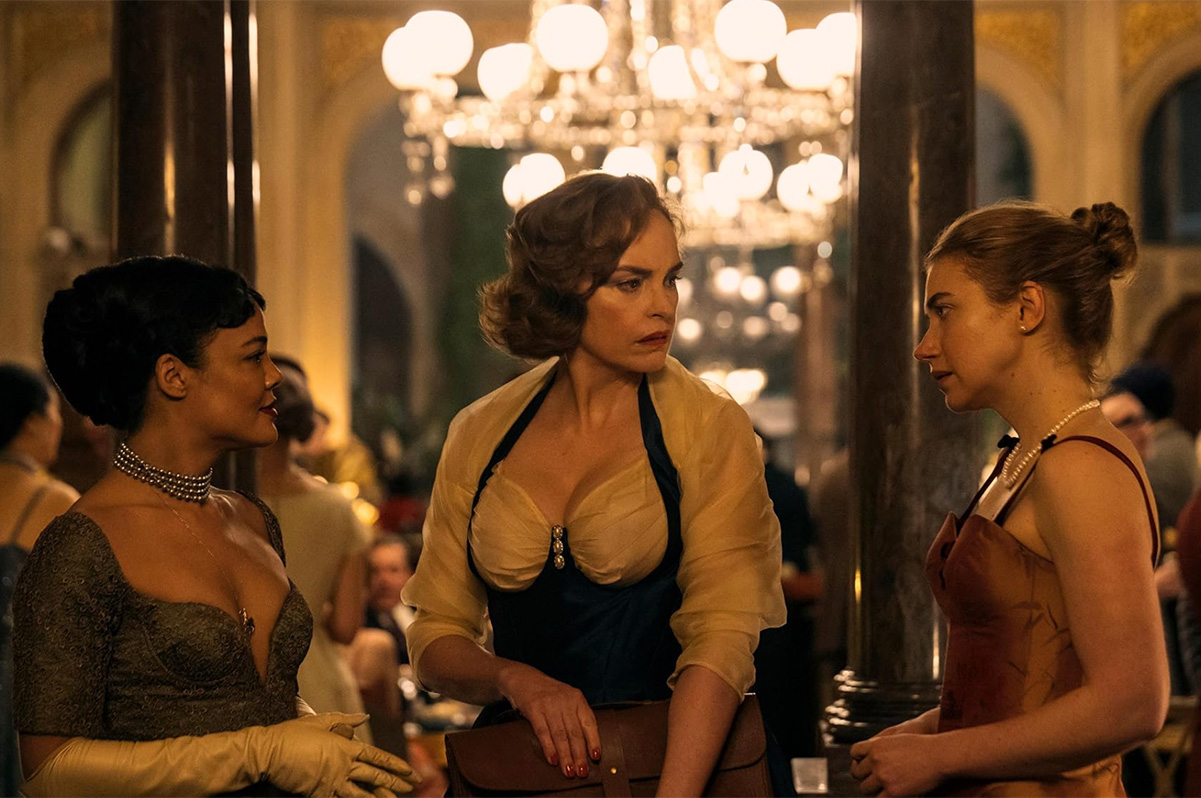
It’s not strictly necessary to know anything about Henrik Ibsen when you watch “Hedda” – the festival-acclaimed period drama from filmmaker Nia DaCosta, now streaming on Amazon Prime Video after a brief theatrical release in October – but it might help.
One of three playwrights – alongside Anton Chekhov and August Strindberg – widely cited as “fathers of “modern theater,” the Norwegian Ibsen was sharply influenced by the then-revolutionary science of of psychology. His works were driven by human motivations rather than the workings of fate, and while some of the theories that inspired them may now be outdated, the complexity of his character-driven dramas can be newly interpreted through any lens – which is why he is second only to Shakespeare as the most-frequently performed dramatist in the world.
Arguably his most renowned play, “Hedda Gabler” provides the basis for DaCosta’s movie. The tale of a young newlywed – the daughter of a prominent general, accustomed to a life of luxury and pleasure – who feels trapped as the newly wedded wife of George Tesman, a respected-but-financially-insecure academic, and stirs chaos in an attempt to secure a future she doesn’t really want. Groundbreaking when it premiered in 1891, it became one of the classic “standards” of modern theater, with its title role coveted and famously interpreted by a long list of the 20th century’s greatest female actors – and yes, it’s been adapted for the screen multiple times.
The latest version – DaCosta’s radically reimagined reframing, which moves the drama’s setting from late-19th-century Scandinavia to England of the 1950s – keeps all of the pent-up frustration of its title character, a being of exceptional intelligence and unconventional morality, but adds a few extra layers of repressed “otherness” that give the Ibsen classic a fresh twist for audiences experiencing it more than a century later.
Casting Black, openly queer performer Tessa Thompson in the iconic title role, DaCosta’s film needs go no further to introduce new levels of relevance to a character that is regarded as one of the theater’s most searing portrayals of thwarted female empowerment – but by flipping the gender of another important character, a former lover who is now the chief competition for a job that George (Tom Bateman) is counting on obtaining, it does so anyway.
Instead of the play’s Eilert Lövborg, George’s former colleague and current competition for lucrative employment, “Hedda” gives us Eileen (Nina Hoss), instead, who carries a deep and still potent sexual history – underscored to an almost comical level by the ostentationally buxom boldness of her costume design – which presents a lot of options for exploitation in Hedda’s quest for self-preservation; these are even further expanded by the presence of Thea (Imogen Poots), another of Hedda’s former flings who has now become enmeshed with Eileen, placing a volatile sapphic triangle in the middle of an already delicate situation.
Finally, compounding the urgency of the story’s precarious social politics, DaCosta compresses the play’s action into a single evening, the night of Hedda and George’s homecoming party – in the new and expensive country house they cannot afford – as they return from their honeymoon. There, surrounded by and immersed in an environment where bourgeois convention and amoral debauchery exist in a precarious but socially-sanctioned balance, Hedda plots a course which may ultimately be more about exacting revenge on the circumstances of a life that has made her a prisoner as it is about protecting her husband’s professional prospects.
Sumptuously realized into a glowing and nostalgic pageant of bad behavior in the upper-middle-class, “Hedda” scores big by abandoning Ibsen’s original 19th-century setting in favor for a more recognizably modern milieu in which “color-blind” casting and the queering of key relationships feel less implausible than they might in a more faithful rendering. Thompson’s searingly nihilistic performance – her Hedda is no dutiful social climber trying to preserve a comfortable life, but an actively rebellious presence sowing karmic retribution in a culture of hypocrisy, avarice, and misogyny – recasts this proto-feminist character in such a way that her willingness to burn down the world feels not only authentic, but inevitable. Tired of being told she must comply and cooperate, she instead sets out to settle scores and shift the balance of power in her favor, and if her tactics are ruthless and seemingly devoid of feminine compassion, it’s only because any such sentimentality has long been eliminated from her worldview. Valued for her proximity to power and status rather than her actual possession of those qualities, in DaCosta’s vision of her story she seems to willingly deploy her position as a means to rebel against a status quo that keeps her forever restricted from the self-realized autonomy she might otherwise deserve, and thanks to the tantalizingly cold fire Thompson brings to the role, we are hard-pressed not to root for her, even when her tactics feel unnecessarily cruel.
As for the imposition of queerness effected by making Eilert into Eileen, or the additional layers of implication inevitably created by this Hedda’s Blackness, these elements serve to underscore a theme that lies at the heart of Ibsen’s play, in which the only path to prosperity and social acceptance lies in strict conformity to social norms; while Hedda’s race and unapologetic bisexuality feel largely accepted in the private environment of a party among friends, we cannot help but recognize them as impediments to surviving and thriving in the society within which she is constrained, and it makes the slow-bubbling desperation of her destructive character arc into a tragedy with a personal ring for anyone who has ever felt like an outsider in their own inner circle, simply by virtue of who they are.
Does it add anything of value to Ibsen’s iconic work? Perhaps not, though the material is certainly rendered more expansive in scope and implication by the inclusion of race and sexuality to the already-stacked deck of class hierarchy that lies at the heart of the play; there are times when these elements feel like an imposition, a “what-if?” alternate narrative that doesn’t quite gel with the world it portrays and ultimately seems irrelevant in the way it all plays out – though DaCosta’s ending does offer a sliver of redemptive hope that Ibsen denies his Hedda. Still, her retooling of this seminal masterwork does not diminish its greatness, and it allows for a much-needed spirit of inclusion which deepens its message for a diverse modern audience.
Anchored by Thompson’s ferocious performance, and the electricity she shares with co-star Hoss, “Hedda” makes for a smart, solid, and provocative riff on a classic cornerstone of modern dramatic storytelling; enriched by a sumptuous scenic design and rich cinematography by Sean Bobbitt, it may occasionally feel more like a Shonda Rhimes-produced tale of sensationalized scandal and “mean-girl” melodrama, but in the end, it delivers a powerful echo of Ibsen’s classic that expands to accommodate a whole century’s worth of additional yearning.
Besides, how often do we get to see a story of blatant lesbian attraction played out with such eager abandon in a relatively mainstream movie? Answer: not often enough, and that’s plenty reason for us to embrace this queered-up reinvention of a classic with open arms.
Movies
Looking through the steam: ‘Sauna’ and queer intimacy
Directed by Mathias Broe, ‘Sauna’ follows a rare trans-cis romance, unfolding inside Copenhagen’s sauna scene.
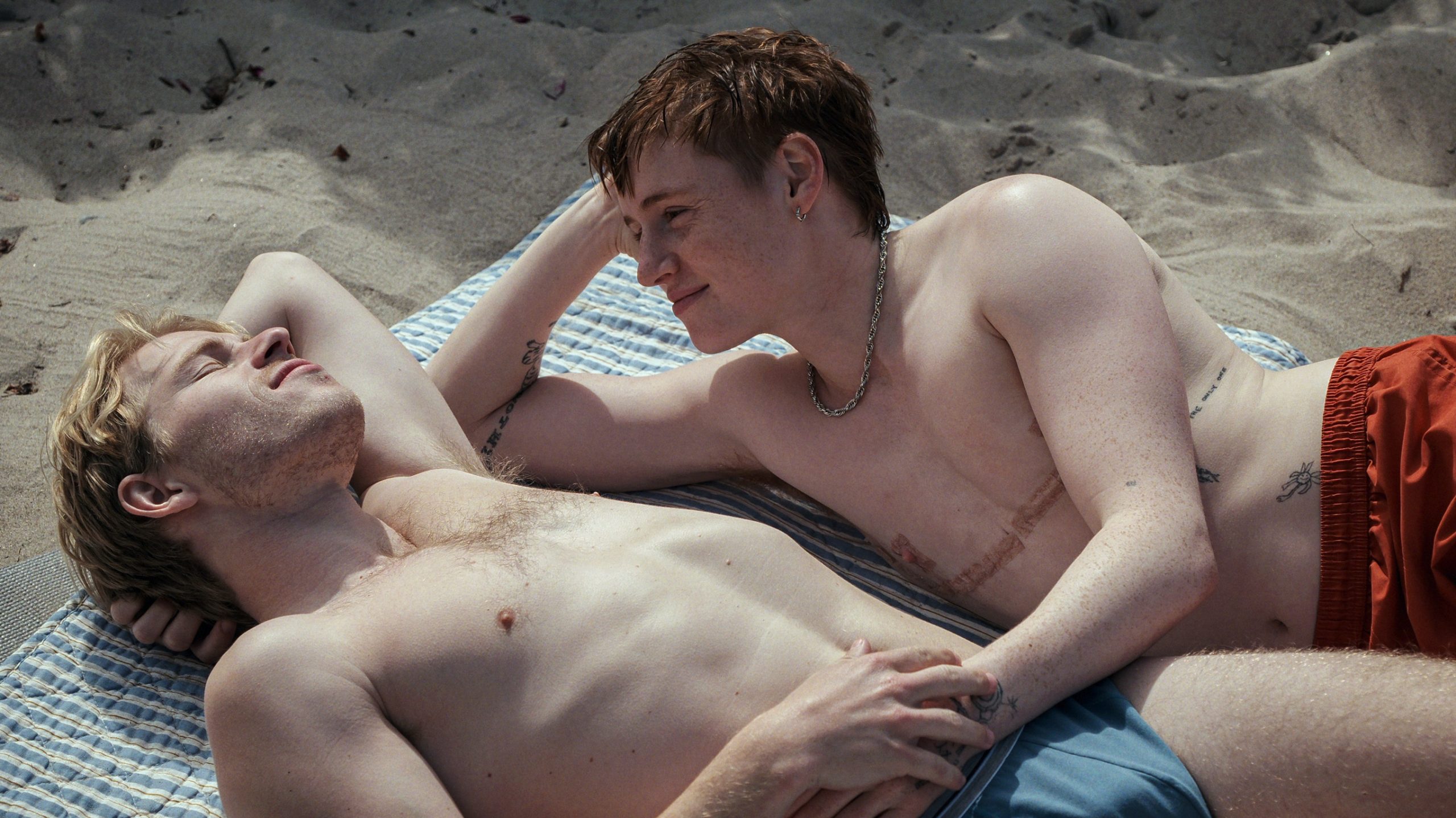
Sauna offers something rare in global queer cinema: a love story between a cis gay man and a trans gay man that refuses simplification. Releasing November 18 through Breaking Glass Pictures, the film marks Danish director Mathias Broe’s atmospheric adaptation of Mads Ananda Lodahl’s acclaimed book. Set amid the charged atmosphere of Copenhagen’s gay sauna scene, it traces the evolving bond between Johan, played by Magnus Juhl Andersen, and William, played by Nina Rask – two characters seeking connection in a world that often misunderstands them both.
Broe isn’t a festival-minded “queer indie” director so much as a working filmmaker embedded in his craft. When he spoke to the Blade, he called from a bus in Denmark, commuting between the film classes he teaches. The detail fits: his approach to Sauna is both grounded and nuanced, shaped by the rhythms of real life rather than industry polish.
For Broe, the film emerged from a desire to make queer life visible in a way that felt truthful to his own world. “I’ve been wanting to do a queer film as my debut film for a really long time … In Denmark, it’s been really hard to find films and stories that I could relate to,” he tells the Blade. When Broe set out to make Sauna, he pursued representation grounded in lived experience rather than abstraction, asking himself, “How do I get the people that I surround myself with onto the big screen?”
Though the film is groundbreaking for featuring Denmark’s first transgender actor in a leading trans role, Broe insists the focus remains on the humanity of its characters. “It was most important to talk about a love story first and foremost … The story is a very universal story about love and identity and belonging.”
Sauna is not a standard bathhouse memoir. It confronts the realities of being trans in cis spaces – and of being cis while dating trans people – inside a setting often mythologized as liberated but marked by its own exclusions. For American readers, the sauna functions much like a bathhouse: a place where intimacy is typically low-commitment and fleeting. Johan moves through it in exactly that way, cycling through encounters that rarely carry emotional weight. Broe said the film deliberately critiques this pace and disposability of app-mediated intimacy: “We wanted to show the side of Johan having these fast hookups and not really taking the time to actually look into who he was meeting.”
But Broe is quick to clarify that Johan is “longing to experience humans” instead of solely casual encounters. That longing crystallizes in his developing relationship with William – a connection that complicates Johan’s habits of fleeting intimacy. Without spoiling too much, the bond between Johan and William hovers somewhere between love and infatuation, a tension that deepens the film’s emotional stakes. Inside the sauna, this dynamic sharpens: the space becomes, as Broe puts it, “a labyrinth, an emotional landscape … searching in the dark… an image of his loneliness and longing.” It’s also where the limits of inclusion inside queer spaces come into view. Broe has seen audiences register this, noting that “a lot of cis gay men” have approached him after screenings saying, “Whoa, I never thought about this…”
The LGBTQ+ community is often described as inherently inclusive, but that narrative obscures both historical exclusions and the ones that persist today. Denmark – frequently imagined as a kind of queer utopia –illustrates this tension. “ I think it’s one of the safest places to be queer,” Broe tells the Blade, “But at the same time, the culture is quite conservative … language-wise and culture-wise, we’re very much behind.” He’s equally candid about the systemic barriers trans people face in healthcare. This pressure weighs heavily on William’s story in the film, where gatekeeping remains the norm: “Someone else has the power to judge if you are who you say you are … some doctor grants you access to who you are as a person.”
What keeps Sauna emotionally grounded is Broe’s insistence on flawed, human characters: “We have to create and tell a story about real human beings and not these flawless characters.” Johan’s arc throughout the film is intentionally non-linear. There is no classic hero’s journey or archetype that Johan fits neatly into. Broe insists that Johan “keeps repeating his own mistakes.”
In the end, Sauna expands queer cinema by refusing to neatly categorize its characters and audience. “We box ourselves so intensely in sexuality and identity,” Broe says, emphasizing that William’s story is central precisely because it challenges those boundaries. As he puts it, “The film tells the community that you can be trans and gay at the same time.”
Broe’s film asks viewers to sit with the messiness of love, transition, and vulnerability. In doing so, it opens a space – one that is steamy, dark, and perfectly imperfect – where queer stories can exist in all their complexity.
Movies
Sydney Sweeney embodies lesbian boxer in new film ‘Christy’
Christy Martin’s life story an inspirational tale of survival
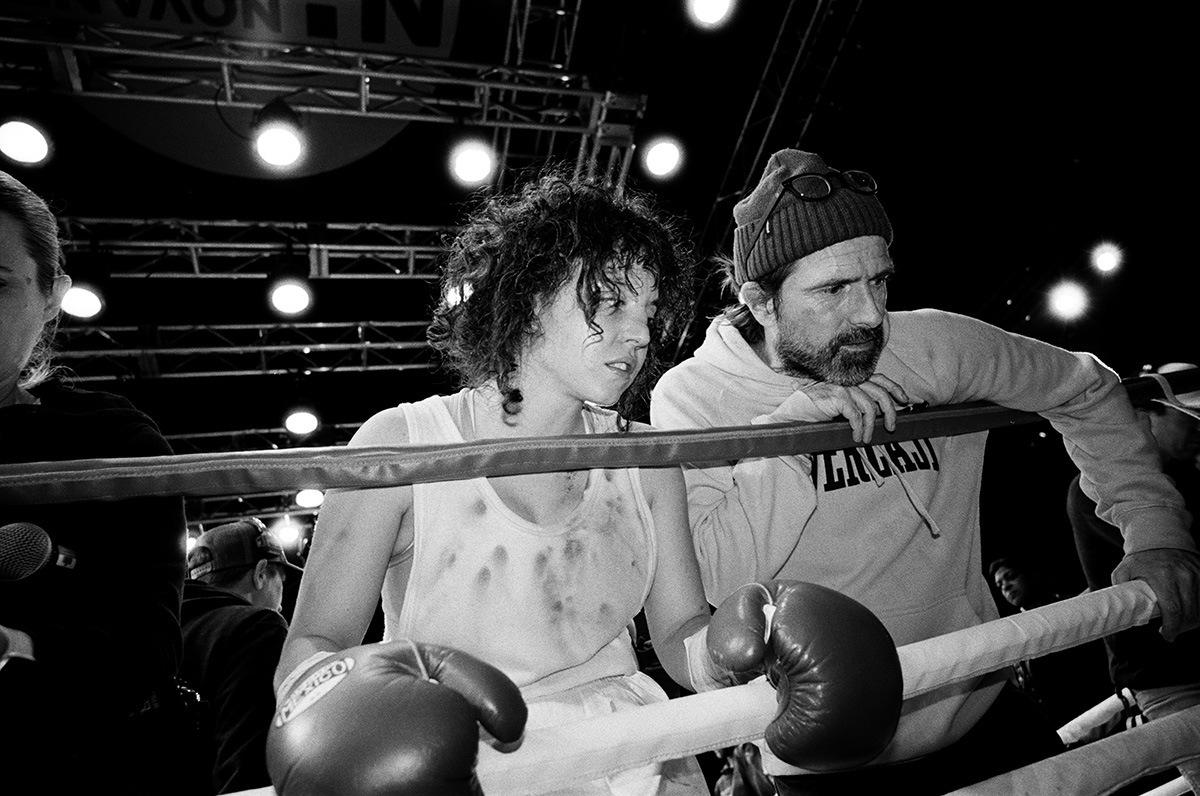
For legendary professional boxer Christy Martin, never in a million years did she expect to see the riveting story of her rapid rise to fame onscreen.
“When somebody first contacted me about turning my life into a movie, I thought they were joking,” Martin said at a recent Golden Globes press event for her movie, “Christy.”
“I was so afraid that my life would be as I call it, Hollywoodized.”
Martin was put at ease once she saw how committed co-screenwriters Mirrah Foulkes, and Australian filmmaker David Michôd were to the material, and how relentless actress Sydney Sweeney was to accurately portray her.
“Mirrah was very fair to me and treated me great on the paper … I feel like this is the most powerful group that could ever come together to tell my story,” she acknowledged.
In “Christy,” viewers see Martin’s combative spirit, in her ongoing quest to win each fight. Under her demanding coach turned manager-husband Jim Martin (played by Ben Foster), Christy is fearless in the boxing ring, yet increasingly troubled as she deals with the pressure of her mother, sexual identity issues, drugs, and a physically abusive marriage that almost ended in death.
“It’s crazy to see anybody, but especially Syd, become me,” she told the Los Angeles Blade. “It’s overwhelming! A little much for a coal miner’s daughter from a small town in southern West Virginia.”
For Sweeney, who is also a producer on the film, playing the courageous lesbian boxer has been a life-changing experience. “This is the most important character I have ever played. It’s the most important story I have ever told or will tell. It’s an immense honor to bring her to life.”
To become Martin, Sweeney worked hard to absorb as much information on her as possible.
“I had the real Christy, and then I had years and years of interviews and fight footage and her book and her documentary on Netflix that I was able to pull from. I like to build books for my characters, to create their entire life, from the day they’re born until the first time you meet them onscreen. So just kind of filling out the entire puzzle of Christy here.”
Sweeney said the many scenes where Martin’s mom couldn’t accept she was gay were immensely challenging to be a part of.
“That was probably one of the hardest scenes for me,” Sweeney noted. “I have very supportive parents, and I can’t imagine what it would be like to not have your mom or dad to turn to ask for help or guidance or just need support. So it was a very difficult scene to process.”
Equally challenging was the rigorous process Sweeney went through in order to become Martin in the movie.
“It was a huge physical transformation for me. I trained for two-and-a-half months before we even started filming, and I put on 35 pounds for the role, so it was a big transformation.”
As difficult as it was to deal with a film that dives into domestic violence, Sweeney was able to shake the character off when she was done at the end of each day.
“I have a rule for myself where I don’t allow any of my own thoughts or memories into a character. So when the moment they call ‘cut,’ I’m back to being Syd, and I leave it all in the scene, and that’s the story that I’m telling. Otherwise I’m just me; so I go home when I’m me.”
Martin hopes that audiences leave the theater with a sense of faith.
“I think we showed a path of how to get out of any situation that you might be in. And also, it’s very important to be true to you. Sometimes that takes a while — it took me a little while — but I’m happy to be true to me. And that’s what we want; the whole story is about being who you are.”
Sweeney would love viewers to walk away and demand to be “Christy Strong.”
“I hope that they want to be kind and compassionate to others around them, and be that helping hand. Christy’s story is singular, and yet her story of triumph, survival and continuation, supports those who are in experiences of domestic violence behind closed doors. She is one of the great champions.”
Sweeney loves that Martin is also a great advocate of new boxing talent. “That spark of life is something that I think at the end of the day, ‘Christy’ is about– it’s the spark to keep going and be who you are proudly.”
Movies
In solid ‘Nuremberg,’ the Nazis are still the bad guys
A condemnation of fascist mentality that permits extremist ideologies to take power

In any year prior to this one, there would be nothing controversial about “Nuremberg.”
In fact, writer/director James Vanderbilt’s historical drama – based on a book by Jack El-Hai about the relationship between Nazi second-in-command Herman Göring and the American psychiatrist who was tasked with studying him ahead of the 1945 international war crimes trial in the titular German city – would likely seem like a safely middle-of-the-road bet for a studio “prestige” project, a glossy and sharply emotional crowd-pleaser designed to attract awards while also reinforcing the kind of American values that almost everyone can reasonably agree upon.
This, however, is 2025. We no longer live in a culture where condemning an explicitly racist and inherently cruel authoritarian ideology feels like something we can all agree upon, and the tension that arises from that topsy-turvy realization (can we still call Nazis “bad?”) not only lends it an air of radical defiance, but gives it a sense of timely urgency – even though the true story it tells took place 80 years ago.
Constructed as an ensemble narrative, it intertwines the stories of multiple characters as it follows the behind-the-scenes efforts to bring the surviving leadership of Hitler’s fallen “Third Reich” to justice in the wake of World War II, including U.S. Supreme Court Justice Robert Jackson (Michael Shannon), who is assigned to spearhead the trials despite a lack of established precedent for enforcing international law. Its central focus, however, lands on Douglas Kelley (Rami Malek), a psychiatrist working with the Military Intelligence Corps who is assigned to study the former Nazi leadership – especially Göring (Russell Crowe), Hitler’s right-hand man and the top surviving officer of the defeated regime – and assess their competency to stand trial during the early stages of the Nuremberg hearings.
Aided by his translator, Sgt. Howie Triest (Leo Woodall), who also serves as his sounding board and companion, Kelley establishes a relationship with the highly intelligent and deeply arrogant Göring, hoping to gain insight into the Nazi mindset that might help prevent the atrocities perpetrated by him and his fellow defendants from ever happening again, yet entering into a treacherous game of psychological cat-and-mouse that threatens to compromise his position and potentially undermine the trial’s already-shaky chances for success.
For those who are already familiar with the history and outcome of the Nuremberg trials, there won’t be much in the way of suspense; most of us born in the generations after WWII, however, are probably not. They were a radical notion at the time, a daring effort to impose accountability at an international level upon world leaders who would violate human rights and commit atrocities for the sake of power, profit, and control. They were widely viewed with mistrust, seen by many as an opportunity for the surviving Nazi establishment to turn the fickle tides of world opinion by painting themselves as the victims of persecution. There was an undeniable desire for closure involved; the world wanted to put the tragedy – a multinational war that ended more human lives than any other conflict in history before it – in the rear-view mirror, and a rush to embrace a comforting fantasy of global unity that had already begun to disintegrate into a “cold war” that would last for decades. “Nuremberg” captures that tenuous sense of make-it-or-break-it uncertainty, giving us a portrait of the tribunal’s major players as flawed, overburdened, and far from united in their individual national agendas. These trials were an experiment in global justice, and they set the stage for a half-century’s worth of international cooperation, even if it was permeated by a deep sense of mistrust, all around.
Yet despite the political and personal undercurrents that run beneath its story, Vanderbilt’s movie holds tight to a higher imperative. Judge Jackson may have ambitions to become Chief Justice of SCOTUS, but his commitment to opposing authoritarian atrocity supersedes all other considerations; and while Kelley’s own ego may cloud his judgment in his dealings with Göring, his endgame of tripping up the Nazi Reichmarschall never wavers. In the end, “Nuremberg” remains unequivocal in its goal – to fight against institutionalized racism, fetishized nationalism, and the amoral cruelty of a power-hungry autocrat.
Yes, it’s a “feel-good” movie for the times (if such a term can be used for a movie that includes harrowing real-life footage of Holocaust atrocities), a reinforcement of what now feels like an uncomfortably old-fashioned set of basic values in the face of a clear and present danger; mounted with all the high-dollar immersive “feels” that Hollywood can provide, it offers up a period piece which comments by mere implication on the tides of current-day history-in-the-making, and evokes an old spirit of American humanism as it wrangles with the complexities of politics, ethics, and justice that endure unabated today. At the same time, it reminds us that justice is shaped by power, and that it’s never a sure bet that it will prevail.
et while it’s every inch the well-produced, slick slice of Hollywood-style history, “Nuremberg” doesn’t deliver the kind of definitive closure we might long for in our troubled times. For all its classic bravado and heartfelt idealism, it can’t deliver the comforting reassurances we desire because history itself does not provide them. The trials were not an unequivocal triumph; though they may have set a precedent in bringing accountability to power on the world stage, it’s one which, eight decades later, has yet to be fully realized. Vanderbilt doesn’t try to rewrite the facts to make them more satisfying, or soften the blow of their hard lessons, and while his movie certainly feels conscious of the precarious times in which it arrives, it doesn’t try to give us the kind of wish-fulfillment ending we might long to see – which ultimately gives it a ring of bitter truth and reminds us that our world continues to suffer from the evil of corrupt men, even when they are defeated.
It’s a movie populated with outstanding performances. Crowe delivers his most impressive turn in years as the chillingly malevolent Göring, and Malek channels all his intensity into Kelley to create a powerfully relatable flawed hero for us to cheer; Shannon shines as the idealistic but practical Jackson, and Woodall provides a likable everyman solidity to counter Malek’s volatile intensity. It might feel early to talk about awards, but it will be no surprise if some of these names end up in the pool of this year’s contenders.
Is “Nuremberg” the anti-Nazi movie we need right now? It certainly seems to position itself as such, and it admittedly delivers an unequivocal condemnation of the kind of fascist, inhuman mentality that permits such extremist ideologies to take power. In the end, though, it leaves us with the awareness that any victory over such evil can only ever be a measured against the loss and tragedy that is left in its wake – and that the best victory of all is to stop it before it starts.
In 2025, that feels like small comfort – but it’s enough to make Vanderbilt’s slick historical drama a worthy slice of inspiration to propel us into the fight that faces us in 2026 and beyond.
Movies
Superb direction, performances create a ‘Day’ to remember
A rich cinematic tapestry with deep observations about art, life, friendship
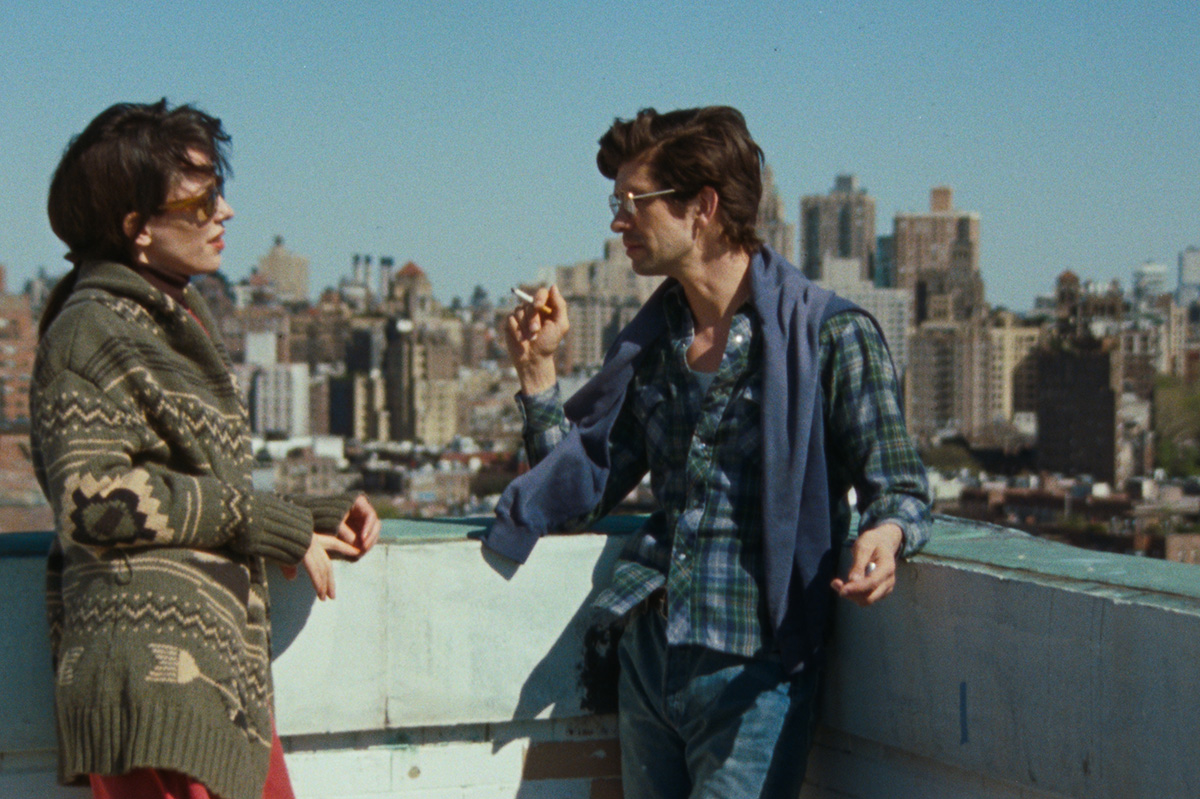
According to writer/director Ira Sachs, “Peter Hujar’s Day” is “a film about what it is to be an artist among artists in a city where no one was making any money.” At least, that’s what Sachs – an Indie filmmaker who has been exploring his identities as both a gay and Jewish man onscreen since his 1997 debut effort, “The Delta” – told IndieWire, with tongue no doubt firmly planted in cheek, in an interview last year.
Certainly, money is a concern in his latest effort – which re-enacts a 1974 interview between photographer Peter Hujar (Ben Whishaw) and writer Linda Rosenkrantz (Rebecca Hall), as part of an intended book documenting artists over a single 24-hour period in their lives – and is much on the mind of its titular character as he dutifully (and with meticulous detail) recounts the events of his previous day during the course of the movie. To say it is the whole point, though, is clearly an overstatement. Indeed, hearing discussions today of prices from 1974 – when the notion of paying more than $7 for Chinese takeout in New York City seemed outrageous – might almost be described as little more than comic relief.
Adapted from a real-life interview with Hujar, which Rosenkrantz published as a stand-alone piece in 2021 (her intended book had been abandoned) after a transcript was discovered in the late photographer’s archives, “Peter Hujar’s Day” inevitably delivers insights on its subject – a deeply influential figure in New York culture of the seventies and eighties, who would go on to document the scourge of AIDS until he died from it himself, in 1987. There’s no plot, really, except for the recalled narrative itself, which involves an early meeting with a French journalist who is picking up Hujar’s images of model Lauren Hutton, an afternoon photo shoot with iconic queer “Beat Generation” poet/activist Allen Ginsburg, and an evening of mundane social interaction over the aforementioned Chinese food. Yet it’s through this formalized structure – the agreed-upon relation of a sequence of events, with the thoughts, observations, and reflections that come with them – that the true substance shines through.
In relaying his narrative, Hujar exhibits the kind of uncompromising – and slavishly precise – devotion to detail that also informed his work as a photographer; a mundane chronology of events reveals a universe of thought, perception, and philosophy of which most of us might be unaware while they were happening. Yet he and Rosenkrantz (at least in Sachs’ reconstruction of their conversation) are both artists who are keenly aware of such things; after all, it’s this glimpse of an “inner life” of which we are rarely cognizant in the moment that was/is their stock-in-trade. It’s the stuff we don’t think of while we’re living our lives – the associations, the judgments, the selective importance with which we assign each aspect of our experiences – that later becomes a window into our souls, if we take the opportunity to look through it. And while the revelations that come may occasionally paint them in a less-than-idealized light (especially Hujar, whose preoccupations with status, reputation, appearances, and yes, money, often emerge as he discusses the encounter with Ginsberg and his other interactions), they never feel like definitive interpretations of character; rather, they’re just fleeting moments among all the others, temporary reflections in the ever-ongoing evolution of a lifetime.
Needless to say, perhaps, “Peter Hujar’s Day” is not the kind of movie that will be a crowd-pleaser for everyone. Like Louis Malle’s equally acclaimed-and-notorious “My Dinner With Andre” from 1981, it’s essentially an action-free narrative comprised entirely of a conversation between two people; nothing really happens, per se, except for what we hear described in Hujar’s description of his day, and even that is more or less devoid of any real dramatic weight. But for those with the taste for such an intellectual exercise, it’s a rich and complex cinematic tapestry that rewards our patience with a trove of deep observations about art, life, and friendship – indeed, while its focus is ostensibly on Hujar’s “day,” the deep and intimate love between he and Rosenkrantz underscores everything that we see, arguably landing with a much deeper resonance than anything that is ever spoken out loud during the course of the film – and never permits our attention to flag for even a moment.
Shooting his movie in a deliberately self-referential style, Sachs weaves the cinematic process of recreating the interview into the recreation itself, bridging mediums and blurring lines of reality to create a filmed meditation that mirrors the inherent artifice of Rosenkrantz’s original concept, yet honors the material’s nearly slavish devotion to the mundane minutiae that makes up daily life, even for artists. This is especially true for both Hujar and Rosenkrantz, whose work hinges so directly to the experience of the moment – in photography, the entire end product is tied to the immediacy of a single, captured fragment of existence, and it is no less so for a writer attempting to create a portrait (of sorts) composed entirely of fleeting words and memories. Such intangibles can often feel remote or even superficial without further reflection, and the fact that Sachs is able to reveal a deeper world beyond that surface speaks volumes to his own abilities as an artist, which he deploys with a sure hand to turn a potentially stagnant 75 minutes of film into something hypnotic.
Of course, he could not accomplish that feat without his actors. Whishaw, who has proven his gifts and versatility in an array of film work including not only “art films” like this one but roles from the voice of Paddington Bear to “Q” in the Daniel Craig-led “James Bond” films, delivers a stunning performance, carrying at least 75% of the film’s dialogue with the same kind of casual, in-the-moment authenticity as one might expect at a dinner party with friends; and though Hall has less speaking to do, she makes up for it in sheer presence, lending a palpable sense of respect, love, and adoration to Rosenkrantz’s relationship with Hujar.
In fact, by the time the final credits role, it’s that relationship that arguably leaves the deepest impression on us; though these two people converse about the “hoi polloi” of New York, dropping legendary names and reminding us with every word of their importance in the interwoven cultural landscape of their era, it’s the tangible, intimate friendship they share that sticks with us, and ultimately feels more important than any of the rest of it. For all its trappings of artistic style, form, and retrospective cultural commentary, it’s this simple, deeply human element that seems to matter the most – and that’s why it all works, in the end. None of its insights or observations would land without that simple-but-crucial link to humanity.
Fortunately, its director and stars understand this perfectly, and that’s why “Peter Hujar’s Day” has an appeal that transcends its rarified portrait of time, place, and personality. It recognizes that it’s what can be read between the lines of our lives that matters, and that’s an insight that’s often lost in the whirlwind of our quotidian existence.
Movies
Sydney Sweeney leads ‘Christy,’ a solid boxing movie about sublimating queer identity and finding redemption
Ultimately, Christy is a decent boxing movie elevated by a much stronger directed second half where violence unexpectedly takes center stage. This is also where Sweeney’s performance kicks into another gear.
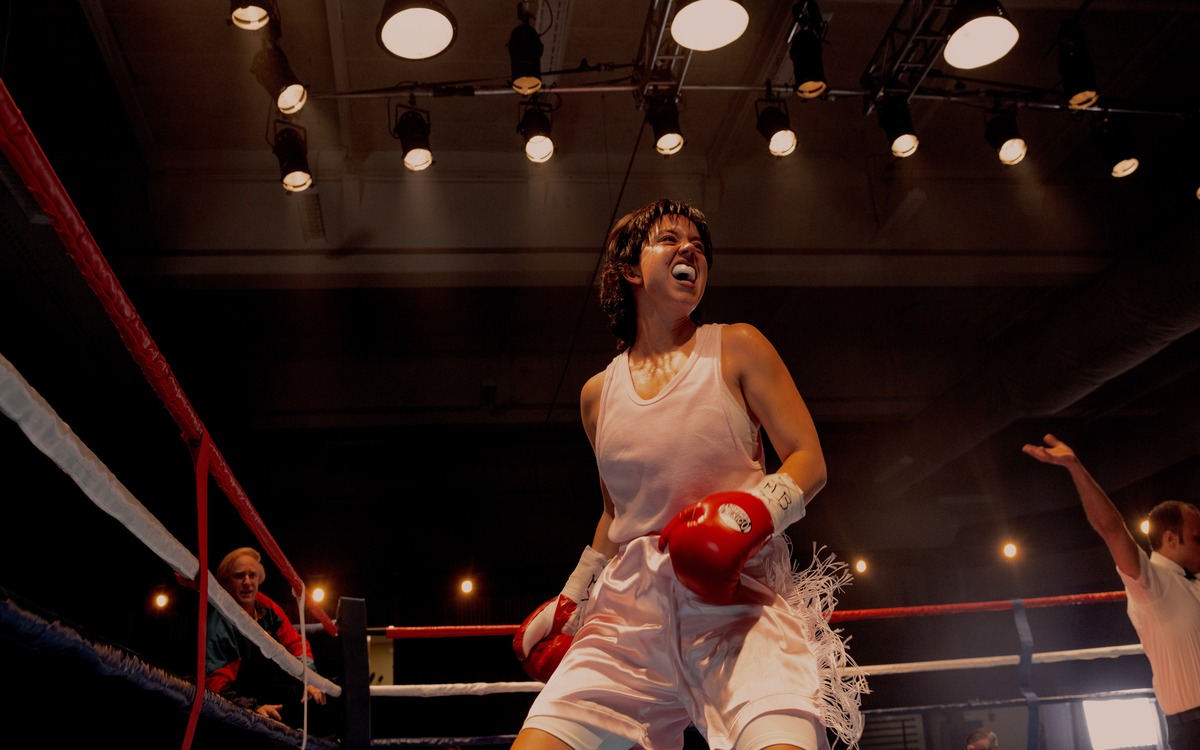
Boxing movies have often been used as vehicles for actors to show what they’ve really got with a transformative, meaty performance. Like music biopics, they can often be constrained by a strict adherence to formula, but in honoring the real-life boxer Christy Martin’s personal story of resilience and survival, director David Michôd (The King) gives Euphoria star Sydney Sweeney the gift of a role in Christy.
The film, the first U.S. release by distribution label Black Bear Pictures, starts off by not shying away from Christy’s queerness, as her quiet, conservative family — mainly her mother played by a never-more-evil Merritt Wever in a bad wig (Marriage Story) — gives her the option of either getting help and stop seeing girls or not receiving any more rent money. Yearning for independence, Christy falls into boxing almost by accident after a break-up, and after quickly falling in love with its raw physicality, finds herself on the forefront of women’s boxing as a sport in the ‘90s. But in marrying her trainer James (Ben Foster), she quickly sublimates her true identity into a hard-as-rock persona. When asked questions by the press about increasing women’s pay and advocating for her fellow boxers, Christy makes it known that she’s not a feminist by nature, throwing out gay slurs just to make the point extra clear.
In the background, away from prying cameras, Christy’s relationship with James grows increasingly volatile. The violence is initially shown offscreen, leaving Christy’s screaming cries for help echoing through her empty home. But eventually, Christy — and the audience — is forced to confront the darkness that lies in plain sight. Michôd and Mirrah Foulkes’ screenplay can’t quite convince us why a man like James has such strong connections to the boxing world, including promoter Don King (Chad L. Coleman). However, it does a good enough job at setting up why Christy sadly finds herself trapped in an abusive relationship.
Ultimately, Christy is a decent boxing movie elevated by a much stronger directed second half where violence unexpectedly takes center stage. This is also where Sweeney’s performance kicks into another gear — watching the life drain from her eyes as she contemplates leaving James, struggling to find her own identity, and realizing that she can’t even turn to her own family. It’s full of complexity that the actor has rarely been able to display with previous roles. The physicality of watching Sweeney in the ring is certainly impressive, too, but it’s also what viewers have come to expect in this specific sub-genre of sports movies. Alongside Sweeney, Foster is an unsettling force of nature here and gives another impressively evil performance.
While the boxing scenes are mostly standard practice, Michôd directs a few key moments and montages with invigorating energy, painting a visceral picture of what Christy’s boxing represented for her as she grows distant from her family and friends. So when a different kind of violence takes center stage, Michôd is able to pull back and let nearly entirely silent scenes play out with terrifying realism. Less is more.
The second half of Christy is also made more interesting by the collision of Christy’s queerness and her coming to terms with not seeing love for women as adversarial to her work in the ring. There’s a tender relationship that blossoms with Lisa Holewyne (Katy O’Brian) and Rosie (Jess Gabor), who Christy confides in as a safety net when she hides away in a hotel room, although these characters feel slightly underdeveloped. The film could’ve benefitted from showing more juxtaposition between the persona that Christy develops and her own self during private moments, and the initial storyline teasing Christy versus her female opponents can feel repetitive.
Beyond some of the awards buzz that Sydney has garnered for her performance, however, Christy should be remembered for what it spotlights about domestic abuse and violence through Christy Martin’s unbelievable story. So for viewers interested in checking it out, it definitely deserves a content warning, and even if it doesn’t fully escape the trappings of boxing biopics, it’s got more up its sleeve than most.
Movies
Queer Broadway icon gets stellar biopic treatment in ‘Blue Moon’
Ethan Hawke delivers award-worthy performance as Lorenz Hart

Even if you’ve never heard the name Lorenz Hart, chances are high you’ve heard some of his songs.
A giant of early 20th century Broadway songwriting, he was a lyricist whose complex blend of wit and wistful romanticism – mostly set to music by longtime composing partner Richard Rodgers – became a significant part of the “Great American Songbook,” performed and recorded by countless musical artists in the decades since. Yet despite his success, happiness eluded him; depression and alcoholism eventually hobbled his career, and he died in 1943 – aged only 47 – from a case of pneumonia he caught after passing out in the rain in front of his favorite bar.
His tragic story might seem an odd fit for a screen treatment from maverick director Richard Linklater, but his latest film – “Blue Moon” in theaters as of Oct. 24 – delivers exactly that. Crafting a mostly speculative and highly stylized portrait of Hart (portrayed in a tour-de-force by longtime Linklater muse Ethan Hawke) on a night that was arguably the lowest point in his professional career: the opening night of “Oklahoma!” – the soon-to-be smash hit composed by Rodgers (Andrew Scott) with new partner Oscar Hammerstein III (Simon Delaney) after their two-decade partnership had been tanked by his personal struggles.
In Robert Kaplow’s theatrically crafted screenplay, Hart shows up early for the post-opening celebration – held, of course, at Broadway’s legendary meeting place, Sardi’s – to hold court with the bartender (Bobby Cannavale) and a young hired piano player (Jonah Lees) while steeling his nerves with a few shots of the whiskey he has sworn to avoid. He’s not there to support his old colleague, however; there’s too much resentment swirling inside him for that. Rather, he’s there to connect with 20-year-old college student Elizabeth (Margaret Qualley), whom he has taken on as a protege – and with whom he has convinced himself he is in love, despite the homosexual inclinations that are mostly an “open secret” within his circle of Broadway insiders.
Constructed as a real-time narrative that follows Hart over the course of the evening, Kaplow’s script could almost be described as a monologue – with interruptions, of course – by the songsmith himself; aided by Hawke’s fearlessly unsentimental performance, the film’s presentation of Hart – a queer man grappling with his own self-loathing in a deeply homophobic era – is almost brutal in its exploration of his emotional and psychological landscape. He has walked a thin line for most of his life, alternately hiding and flaunting his inner truth to navigate his world for decades; and the strain has taken its toll – once heralded as one of Broadway’s brightest talents, his reputation has been ravaged by rumor and he occupies his time by escaping his loneliness through self-denial and liquor. He’s become that guy at the bar who regales you with larger-than-life stories while peppering them with barely concealed bitterness and regret; you can’t help but feel empathy for him, but you’d love to politely extract yourself from the situation at the first opportunity.
There’s something relatable about that situation – from both perspectives – and that’s what keeps “Blue Moon” from becoming insufferable. It’s the kind of movie that makes us cringe, not over the pathetic behavior of its leading character but in anticipation of the next uncomfortable development that’s sure to come as a consequence. He’s a seasoned raconteur, with a polished wit and a prodigious skill with language, and we find ourselves pulling for him both in spite and because of the sense of manic desperation we can feel behind his words.
It’s that almost-grudging empathy we feel for him that gives “Blue Moon” a sense of humanity in the face of what might otherwise seem a relentlessly bleak character study, and keeps us from judging Hart’s impulses toward self-delusion and self-destruction too harshly; and in the end, Linklater’s biopic leaves us with a perspective on his life that emphasizes the legacy he left behind – the poignant lyrics that bespoke an unfulfillable longing for love and connection – and the lasting influence he cast over the generations that succeeded him.
To underscore the latter, the movie imagines a few fortuitous encounters during the festivities at Sardi’s, in which Hart unknowingly drops nuggets of inspiration for such future icons as author E.B. White and a very young Stephen Sondheim. The meetings may or may not not be flights of fancy, but they convey the lasting impact of Hart’s creative contributions in a way that not only feels truthful but provides some amusing moments for buffs of Golden Age Broadway-and-Hollywood lore.
In fact, it should be said that “Blue Moon,” despite the underlying melancholy and the squirm-in-your-seat discomfort that hovers around its edges, is a thoroughly entertaining film; constructed like a play, shot in a style that evokes the cinema of the era (with ongoing references to “Casablanca” to underscore the connection), and wrapped in the nostalgic glow of old Manhattan in its elegant heyday, it bubbles with the kind of wryly sophisticated humor that marked so much of Hart’s own work and thrills us with the feelings it sparks within us.
For that, we must again point to Hawke’s award-worthy performance as the core element; though he accomplishes a physical transformation into the short, balding Hart and masterfully captures his flamboyant personality, it’s the actor’s understanding of the songwriter’s inner landscape that gives the movie its heart, soul, and painfully human perspective.
Even so, it’s a movie with an entire cast’s worth of superb performances. There’s Scott’s carefully measured Rodgers, balancing genuine friendship with the frustrated impatience of navigating a strained relationship in public. Qualley walks a similar tightrope as the object of Hart’s misguided affections, charming us with authentic fondness and diplomatic compassion, and Cannavale provides a solid ground of streetwise wisdom as the bartender who might be his best friend. Patrick Kennedy’s E.B. White, bringing a welcome note of respect and insight, is also a standout.
Yet while the acting in “Blue Moon” may be excellent across the board, it’s Linklater’s direction that drives his cast’s work and ties it all together; a proven chameleon behind the camera, he embraces the theatrical structure of the screenplay with a perfectionist’s aesthetic, and indulges his fascination with time by encapsulating the portrait of a man’s entire life into the observations that can be gleaned from a single night. More importantly, perhaps, he honors his subject by refusing to define Hart’s sexuality to fit modern sensibilities. We can draw whatever conclusions we want, but in the end we have no reason to reject the songwriter’s description of himself as “ambi-sexual” – even though, with its undercurrent of jealousy between two ex-partners, it’s hard not to take note of some very gay implied subtext.
In the end, Hart’s sexual “label” is irrelevant; his loneliness is what matters, the longing to love – and to be loved – which we all share, regardless of our sexual makeup.
It’s the tragic beauty of that universal pang that comes through in all of the timeless lyrics that Lorenz Hart wrote, and it comes through in Linklater’s excellent movie, too.
Movies
Kristen Stewart talks ‘The Chronology of Water,’ the vulnerable debut feature that proved “impossible” to make (AFI Fest)
“It’s about the things that come out of us,” Stewart says of what attracted her to Lidia Yuknavitch’s 2011 memoir

It took eight years for Kristen Stewart to get her ambitious directorial debut, The Chronology of Water, independently made and financed, and she’s been open about how “impossible” the entire process was following its buzzy Cannes premiere. But for the award-winning actor and writer, the prospect of making something “boring” was more terrifying.
“Being an actor has absolutely fucking nothing to do with the reason that we got this thing made because nobody could have,” Stewart said at a post-screening AFI Fest conversation on Oct. 26, moderated by IndieWire’s Editor-at-Large Anne Thompson. “Logistically, the only reason I was really able to do it is because I had met some people who were at some point sick of hearing me complain about it and just went like, ‘Okay. I’ll try and connect you with the people that can actually realize this.’”
Now with a U.S. distributor in The Forge backing the project, Stewart’s adaptation of Lidia Yuknavitch’s 2011 memoir of the same name will have an Oscar-qualifying theatrical run. The Chronology of Water recounts the author’s personal experiences (played on-screen by a fearless Imogen Poots) through violent family abuse, trauma, and her own relationship with the female body over multiple decades. “I’ve loved a lot of books in my life, but this felt like it should be a movie because it could really have its own body and have its own memory and life,” Stewart said. “[It’s] a movie that is super faithful to the book, not because it’s obsessed with the details, but because it’s obsessed with the form and how it breaks and then reforms itself.”

Thora Birch, who plays Lidia’s sister in the film, admits that she was initially “confused” about how to approach the character. “But then once I realized that I’m just existing in the form of someone’s memories, it was a little bit more freeing,” Birch said. And she explains that as somebody who started acting as a child in films like Hocus Pocus and American Beauty, she had a shorthand and shared understanding on-set with Stewart, a former child actor herself.
While Poots wasn’t present at the screening, Birch spoke highly of her co-star: “She carries the film, basically in a close-up, and that’s incredibly difficult to do. And so my experience working with her was [wanting] to be there and present for her, but also [giving] her a little space … One day, there [were] some eye drops that gave her a really bad reaction, she couldn’t work for like an hour. Normally, you would see a visible reaction from any actor or actress, but she was like, ‘Everything’s fine.’”
Stewart explained why Poots was the right choice to portray Lidia: “Some of my favorite movies ever are when you just cannot get with the decisions that, you know, the woman makes. It’s just [Imogen’s] fucking face! And it’s like how present in this moment she was … There was a mutual rupture that was ready to go, and she’s been working for a long time.”

For the visual look of the film, Stewart shot on 16mm and wanted it to “feel out of time,” like something the audience found hidden away in an attic. The story becomes forceful and visceral through editor Olivia Neergaard-Holm’s (The Apprentice) abrupt style, often cutting conversations and scenes short as Lidia is reliving her uncomfortable memories: “The film encouraged us to cut when we wouldn’t have thought to cut because sometimes that’s, like, what happens when your neurons don’t fucking fire,” Stewart said. “That’s often what it feels like to try and grab at the drags of memory.”

Blood is a key motif, starting from the opening scene. That symbolism, and depicting the female body, was important for Stewart. “It’s not always your choice, but it is something that you have to hold in your fucking hands. And the viscosity of that speaks so much to where it comes from, what it means in given moments,” she said. “[The book] wasn’t just about the things that happened to this person — it’s about the things that come out of us. All of us.”
And when asked by Thompson if the offers have started pouring in for her second feature, Stewart remained as honest as ever: “No! We have to do it again ourselves with our bare fucking hands.”
The Chronology of Water played at AFI Fest, which runs Oct. 22-26 at the TCL Chinese Theatre in Los Angeles. The film will have a U.S. theatrical release in December.
-

 California1 day ago
California1 day agoHate crimes targeting transgender and gender nonconforming people have tripled since 2013
-

 Books3 days ago
Books3 days ago‘Dogs of Venice’ looks at love lost and rediscovered
-

 Crime & Justice4 days ago
Crime & Justice4 days agoSan Fernando Valley LGBTQ+ community center Somos Familia Valle is trying to rebuild from a “traumatizing” break-in
-

 a&e features2 days ago
a&e features2 days agoAllison Reese’s advice? Take your comedic medicine.
-
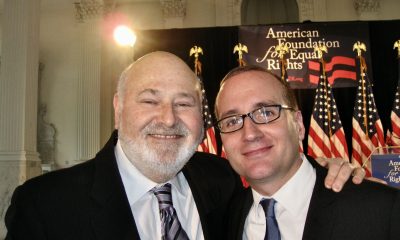
 COMMENTARY3 hours ago
COMMENTARY3 hours agoWhy Rob Reiner’s murder hit this old lesbian hippie so hard
-

 a&e features2 hours ago
a&e features2 hours agoIndya Moore on history-making Gotham Award nomination and speaking out on social media: “It has complicated my access to work”



